 Ducks
of the Cross
Ducks
of the Cross
Sydnordisk
Akademi for Donaldisme - Institute of Donaldistic History
 Ducks
of the Cross
Ducks
of the Cross
Crusade
in medieval Stella anatium
Inaugural
lecture by visiting professor dr.don.ital. Giovanni Jacobini, SAD 2006
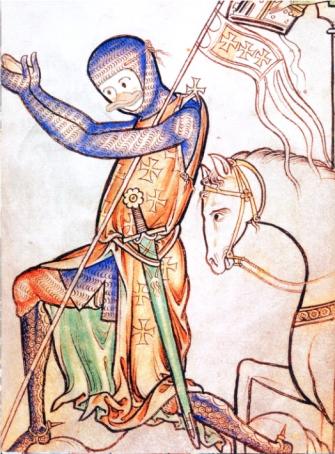
“The Ducks do not know of sex or drugs, they have no religion and they never go to war!”
Nonsense, of course, but such ideas are still surprisingly prominent in large parts of international Donaldism in spite of serious scholars’ manifold proves to the contrary. In stead of just getting frustrated by this, we must strengthen ourselves and realize that old, rooted traditions are hard to get rid off, no matter how wrong and obviously diluted they may be, and so the probably never-ending battle against ignorance and heresy continues. One of the strongholds of the good side in this battle is the South-Nordic Academy of Donaldism, and it is therefore with great pride that I have accepted this invitation to be assigned as visiting professor at the SAD for the coming year, with the explicit task of bringing more focus to Italian Donaldism within the halls and colleges of this fine Academy; I shall try my best to prove worthy of this great honour.
With
the fine work of Dr Gjøgsig at the Institute of Donaldistic Sexology,
SAD has left no excuses for donaldists in the south-Nordic area to keep seeing
Duckburg as a non-sexual place. My esteemed predecessor in this
visiting-professor chair, Dr Hop van de Haavelouw, has only too well proven the
shocking use of drugs and alcohol in Duckburg, and now I think it is time to
turn to two of the remaining taboos of Donaldism: Religion and war. Today, I
will do this by even combining them in something traditionally completely
unheard-of in Donaldistic circles, namely religious warfare! I will ask
you to join me in a trip back to the Middle Ages of Stella anatium, to see how
it went on, when Ducks took the Cross to fight a Holy War against the infidels.
My
paper is based on a duckumentary by the Italian reporters Nino Russo (text)
& Andrea Freccero (pictures) from 1997, first published in Topolino
(Libretto) no. 2150, and now available in a Danish version in Jumbobog
no. 199, from where the illustrations here are taken. The story is part of the Chronicles
of Donald Lionduck (It.: Paperleòn, Da.: Anders Løveand),
which are unfortunately undated, but to judge from the depicted settings, I
would dare to set an approximate date to the high Middle Ages, equivalent to the
12th-14th centuries of our world. Among other things, this
date builds on observations of the architecture, where several windows are
constructed in an Early Gothic style (known in our world from the late 12th
century), and the hall of Scrooge McDuck’s ancestor seems to be vaulted in a
High Gothic style, which was not common until the 14th century.
Donald’s
- as well as our - first meeting with the crusade concept takes place in the
small town of Duckthorpe (Da.: Andetorp), a place, which the sources do
not make it possible to locate any closer than to somewhere in Europe.[1]
Here we witness the popular greetings of a local warrior, Captain Crushstar
(Da.: Kaptajn Knusenstjerne), and when Donald asks Daisy why this guy is
so popular, she explains that he is a Knight of the Cross - something that she
thinks Donald should be able to see.
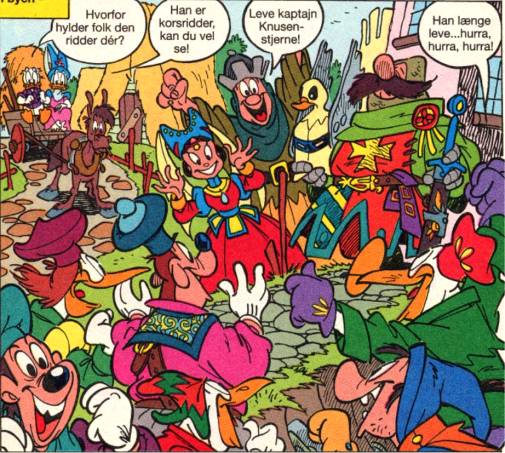
As we shall learn, the easiest way to identify a Knight of the Cross from any other knight is by his coat of arms: A yellow cross on a red background. Captain Crushstar, a Human or Humanoid himself, also carries with him a pale yellow helmet in the form of a duck (with a small d, i.e. of the zoological type) with iron wings. This type of helmet is, however, only duckumented in this individual case.
The
popularity of the Knights of the Cross, we learn, is not based on any particular
skills in solving crossword puzzles, as first suggested by Donald. No, people
praise the knights because they are going on a crusade (the knights, that is,
not the people).

Popularity
is not the only reward for those who chose to join the knighthood - an
opportunity, which seems to be open to all layers of society. Even to Donald’s
cousin Fethry.
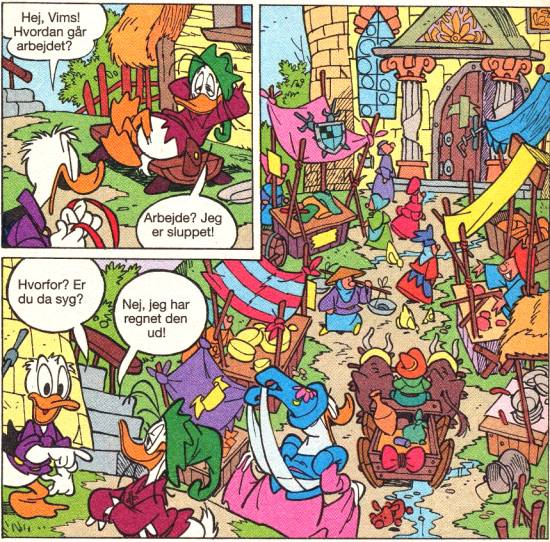
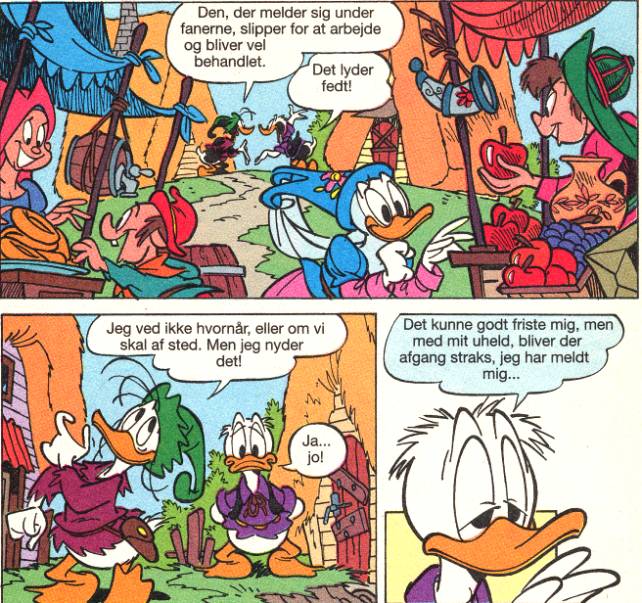
A
volunteer, who has taken the Cross and by so promised to join the next crusade,
enjoys numerous privileges in society. Most importantly, he is free of any
working obligations, which would indicate that either the knighthood or the
remaining society (or the Church?) is to take care of his worldly needs.
Naturally, such luxury will tempt certain elements of society to take the Cross
in the hope that the actual departure for the crusade will never be implemented,
whereas a realistic Duck such as Donald knows that the next crusade will be
proclaimed immediately after his potential enlisting. By this argument, Donald
lets us know that going on an actual crusade is not something to be taken
lightly.
Turning
back to the associated pre-crusade privileges of someone who has taken the
Cross, we learn that the exemption from work holds a very high recognition in
society. When Donald - falsely - claims to have taken the Cross and, furthermore,
been appointed captain by the crusade committee, even a hardcore lay lord as his
uncle Scrooge has to comply.
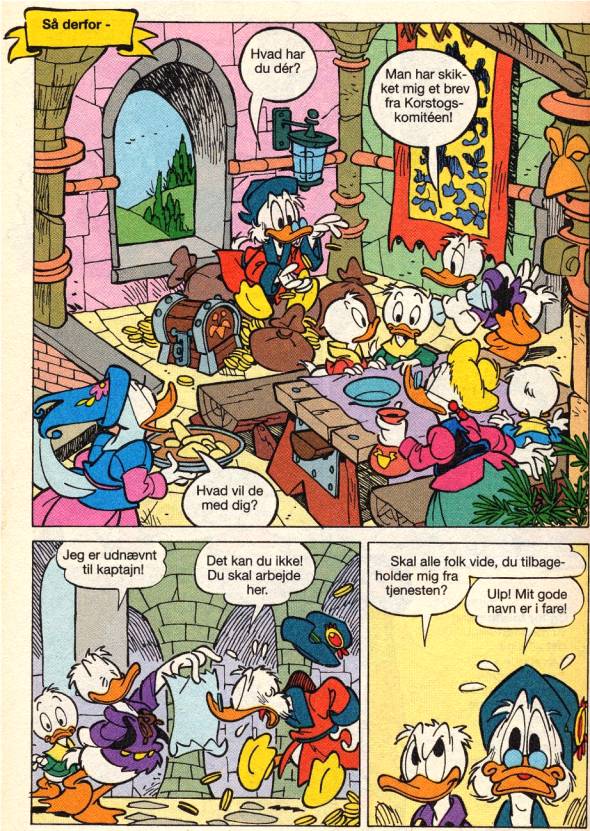
If
not, Scrooge’s name and reputation will be damaged, and - according to Donald
- the community will punish him by taking all his possessions.
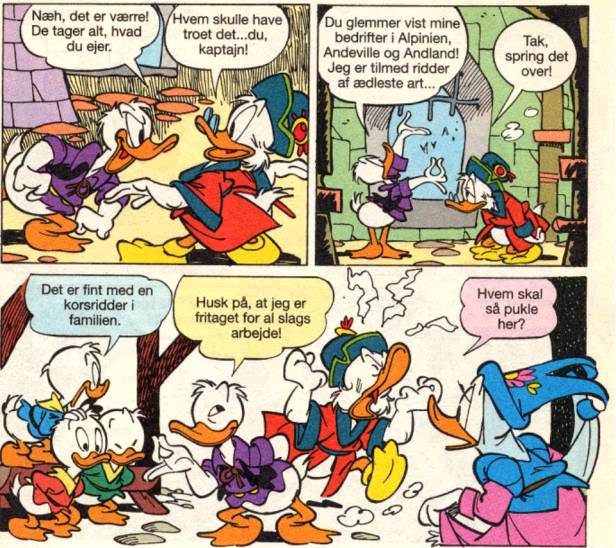
It
is not clear exactly what group within society that holds such a potential,
penalizing power towards a normally fearless character as Lord Scrooge, but
clearly, the rich uncle knows when he is beaten. Unfortunately, the sources do
not mention anything about how to join the knighthood or to whom you enlist for
the crusade. Only, we hear of a Crusade Committee, who obviously pulls a lot of
weight, but whether it is based in the Church or in a purely secular, militant
community is not evident. However, the sign of the Cross and the whole concept
of crusade surely points to an important religious content. One might even add
that the above-mentioned helmet of Captain Chrushstar in the shape of an
armoured duck with the almost angel-like iron wings could hold great
religious-symbolic importance: Are they fighting for (or with) Saint Duck
or perhaps even Notre Duck known from the later cathedral of Duckburg?
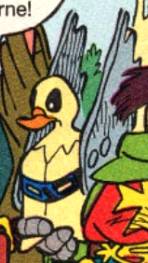
Admittedly,
a religious aspect of taking the Cross does not appear to have been the major
concern of neither Fethry nor Donald, especially not for the latter, as he
deliberately chooses to exploit the whole concept by falsely letting his
surroundings believe that he has joined the Knighthood of the Cross and that he
is leaving for the crusade - when in fact he has only been appointed captain of
the local crossword-puzzle-team participating in some abroad competition. This
does not withhold him from fully enjoying the privileges of the true crusaders,
which apart from the exemption of work includes outspoken local popularity and
sweet looks from many a young maiden.
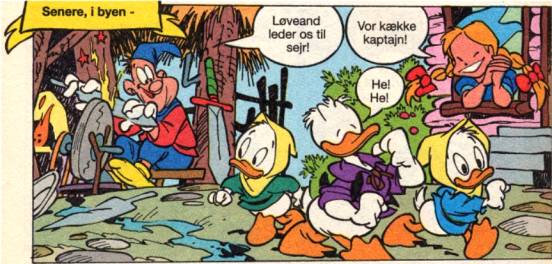
Naturally,
such impious hybris must meet with its nemesis. Instead of going
to the planned crossword-competition on the Mediterranean “Island of Beauty”,
Donald’s ship due to heavenly interference brings him to less friendly soils
in the Middle East of Stella anatium.
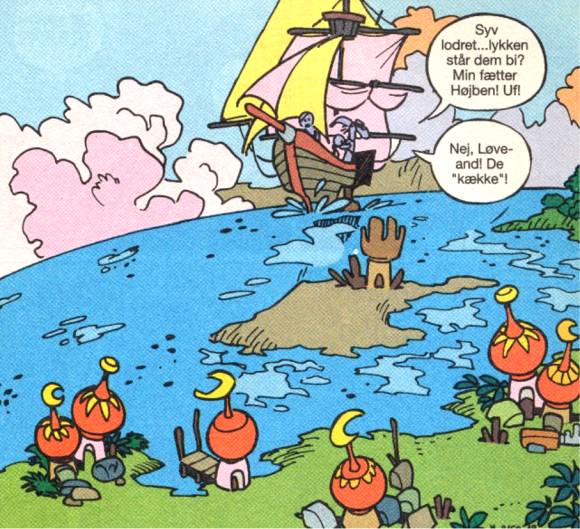
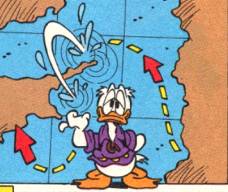 The
chronicle itself only states that Donald has arrived in the Orient (the
Norwegian version uses the more Viking-loaded term Østerled), but from a
later map in the chronicle showing Donald Lionduck’s energetic route of
departure, it would seem that he has landed in a place equivalent to the Terra
Sancta of our world, more precisely somewhere close to the crusader’s port
of Tripoli. Together with the even more famous port of Acre, Tripoli was one of
the last bastions of the Kingdom of Jerusalem to fall in 1289 (soon to be
followed by the fall of Acre in 1291). In Stella anatium, the coastal settlement
of this country is characterized by quite small houses with relatively big,
rounded roofs, all of them equipped with an ornamental spire, of which two
thirds are in the shape of a (more or less) half moon; the well-known symbol of
Islam!
The
chronicle itself only states that Donald has arrived in the Orient (the
Norwegian version uses the more Viking-loaded term Østerled), but from a
later map in the chronicle showing Donald Lionduck’s energetic route of
departure, it would seem that he has landed in a place equivalent to the Terra
Sancta of our world, more precisely somewhere close to the crusader’s port
of Tripoli. Together with the even more famous port of Acre, Tripoli was one of
the last bastions of the Kingdom of Jerusalem to fall in 1289 (soon to be
followed by the fall of Acre in 1291). In Stella anatium, the coastal settlement
of this country is characterized by quite small houses with relatively big,
rounded roofs, all of them equipped with an ornamental spire, of which two
thirds are in the shape of a (more or less) half moon; the well-known symbol of
Islam!
In
spite of the romantic looking coast-settlement, the Ducks soon realize that they
have landed in the middle of a very dramatic turmoil. Hardly has Donald Lionduck
waddled ashore before he runs into a heavily armed (and armoured) contingent of
Knights of the Cross - as always easily recognized by their coat of arms: The
yellow cross on a red background.
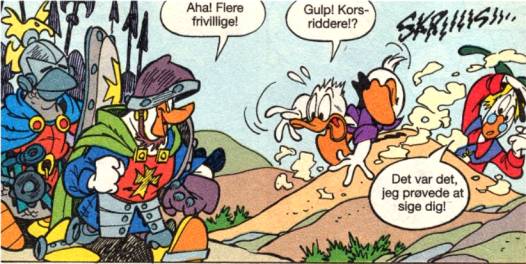
Although
Donald does not bear the symbol of the knighthood, the captain of the crusading
army immediately takes him for a friend and not a foe - even though Donald’s
reaction by the first sight of the knights would rather suggest the latter.
Probably, the reason for this is that Donald is a Duck, and according to the
believes of the captain, all Ducks must be fighting on the side of the Good. The
captain himself is obviously also of the Anatide species, although rather a
Goose or a Swan. As for his armoured followers, the species is not easily
established, but the orange colour of the legs of the knight right behind the
captain, together with the beak-protecting construction on his helmet, strongly
indicates yet another Anatide.
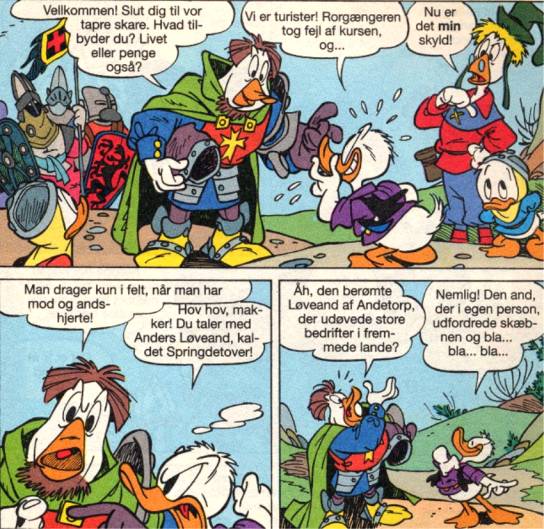
By
the captain’s peculiar accent (“Vellkommen!”) we can
probably conclude that he is not of the same home region as Donald, but on the
other hand, he is not more foreign from the brave Duck than he has heard of the
legendary Donald Lionduck of Duckthorpe. And a heroic knight of this calibre is
a most welcome reinforcement of the crusaders’ army. Indeed, the captain does
not even hesitate to claim that Donald has been sent by divine Providence!
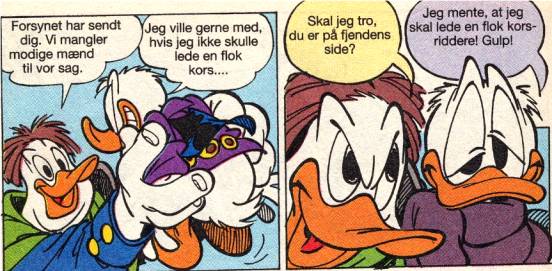
Once
again, we understand that this is not just any adventurous band of warriors
looking for action, honour and fast looting. This is an army fighting for a
cause highly elevated from mere personal ambitions: They are on a mission
from God!
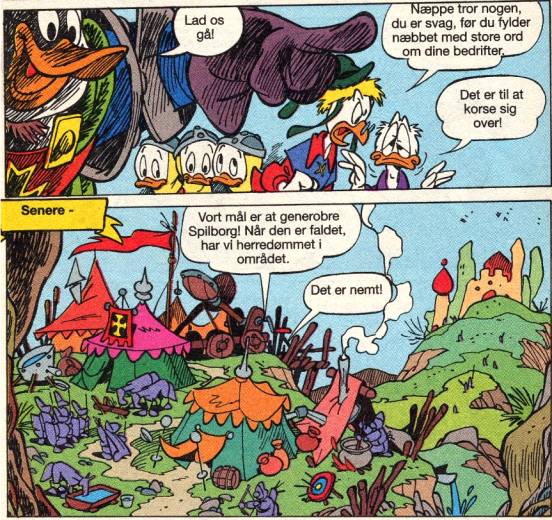
Donald
Lionduck’s company has no choice but to follow the platoon of knights to the
camp of the crusaders. The camp is located on a hill-top lying opposite to a
fortress built on an ever higher hill: Gameburg (Da.: Spilborg).
Allegedly, Gameburg was in an earlier stage of the war held by the crusaders, but apparently, it
then fell in the hands of the enemy. According to the captain, the forthcoming
military move of the crusaders will be an attempt to reconquer the fortress.
A
Gameburg
is unknown in the historical sources of the Terra Sancta of our world.
It is worth noticing, though, that at an inland position not so far away from
Tripoli, the crusaders of the high Middle Ages raised the famous fortress of Krak
des Chevaliers. The impressive fortress was a very important stronghold of
the crusaders in the northern part of the Christian kingdom until it was
captured by the Muslims in 1271.
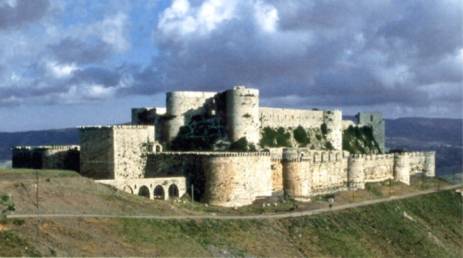
Could
it be that Gameburg is Stella anatium’s equivalent to the Krak des Chevaliers? Or
perhaps even more interesting, that the name Krak des Chevaliers actually
is an Earthly corruption of an original Donaldistic name Quack des Chevaliers?
These are indeed interesting questions that need more looking into.
Whereas
the Krak (or Quack) des Chevaliers of our world was never recaptured by the
Christians after it fell to the Muslims, this is, however, the firm aim of the
Anatide captain in the case of Gameburg. Someone, most probably Donald Lionduck, even
adds that this should be easy! Just as the crusaders of our world, Donald,
however, soon after come to realize that such a recapture is by no way an easy
task. Donald Lionduck and his friends constitute the valiant - although rather
unwilling - vanguard of the crusaders’ attack and here they meet with a
formidable foe in form of fierce, fearless and foreign-looking fighters.

The
enemy garrison of Gameburg is constituted by a rich ethnic mixture of Kynoids,
Ornitides, Porkusides and Humans. While this does not differ much from the
ethnic look of Duckthorpe, apart from the notable absence of Ducks, the
difference is quite evident when looking at the general dress-code (including
hat-wear) and weapon-style of the enemies: It is obviously Oriental, going from
Arabic to Mongolian. No religious orientation of the Orientals in Gameburg is
explicitly stated in the chronicle, but it is probably far from coincidental
that they have decorated one of the onion-shaped cupolas of a stately looking
building with the religiously loaded symbol of the half moon!
To
the Oriental holders of Gameburg, their European visitors are quite clearly not
welcome. Well, actually they might be, but then only as an exotic culinary
change from the otherwise boring garrison-cuisine, but Donald has apparently no
intention of ending his knightly career as chopped Duck.

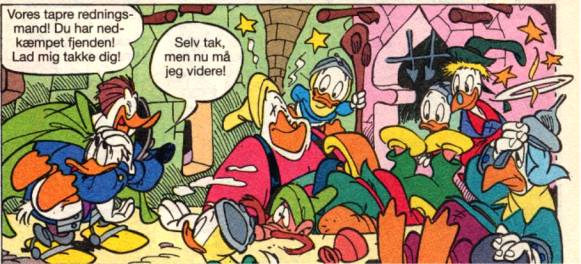
By
a most clever manoeuvre, brave Donald Lionduck manage to neutralize his
aggressive opponents by the means (and jars) at hand (and head), and soon after
the main force of the crusading army can retake the fortress, all thanks to the
Duck of the day. But like all true heroes, Knight Donald does not want to hang
around and celebrate his glorious deed: »But now I must go on!« One can
almost visualize how the Ducks, after securing continued Anatide control in the
Middle East, sail into the sunset towards new adventures.
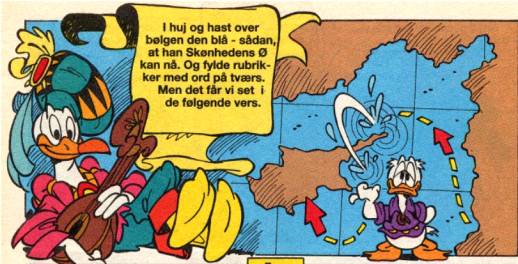
Certainly,
according to the chronicler’s cartographic representation of Donald
Lionduck’s itinerary after the encounters in Gameburg, the merry company sails out
from somewhere similar to Tripoli and - taking a rather peculiar route - lands
on the south side of a big island, looking overwhelmingly like Cyprus of our
world, but explicitly known as The Island of Beauty in medieval Stella
anatium. As you might recall, this was indeed the original destination of
Donald, and now, after being mollified by his good doings, the divine forces let
the Anatide knight complete his mission. Well, almost, as the crossword
competition is of course all over and someone else has taken the trophy. In
spite of this, the rather disappointed Donald prefers to stay on the Island of
Beauty instead of going back to the smelly stables of Duckthorpe, but the
well-informed winner of the competition advises him strongly against such a
decision: The enemy threatens to attack the island!
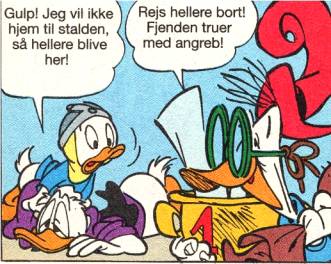
As
it is not explicitly stated who the enemy is, we must expect this to be
self-given, and therefore it is probably the same enemy that the crusaders were
fighting on the Oriental mainland. Once again, it is tempting to compare with
the crusading history of our world. After being expelled from the mainland of
the Kingdom of Jerusalem with the fall of Acre in 1291, the permanent force of
the crusaders’ army was transferred to the islands of Cyprus and Rhodes. The
idea was to organize a reconquest of Terra Sancta from here, but instead the
Muslim forces continued their progressive campaign and finally managed to drive
out the knights from Rhodes in 1523. This meant the actual end of the crusading
plans to the Holy Land, but the romantic dream of it and the knightly orders
continued long after - to some extent even till today.
Turning
back to Stella anatium, it is therefore interesting to note that the national
colours of present-day Duckburg (or at least the colours of the national
football team) are in fact the very same as for the medieval Knights of the
Cross: Red and yellow!

Does
this indicate that the Ducks, who founded Duckburg in Early Modern Times,
originate from one of the same places in Stella anatium’s Europe that sent out
brave warriors like Donald Lionduck in the medieval crusade to the Orient? And
is the memory of this past still such a profound part of the national identity
of Duckburg that their football team has chosen to fight on the green
battlefields of today in the very same colours as the knights?
And
who the quack are the dubious Knight Templars, who are still so
conspicuously present in Duckburg, even though they attempt to keep a facade of
being a secret society? Are we dealing with a politically influential group
based on medieval religious-militant ideas? What temple are the knights named
after? And are the strange-looking pillars outside the building in fact
depicting the frightening helmets of Anatide crusaders? Could it be that the
Knighthood of the Cross is still represented in modern Duckburg? And that it is
they who are behind the construction of the Cathedral of Notre Duck in honour of
their crusade patron?

Well,
the derived questions are as manifold as they would seem impossible to answer.
But as true scholars, we are not just free, but indeed obliged to speculate.
Admittedly, at first sight, it is difficult to find any sign of the old
well-known symbol of the medieval Knights of the Cross on the otherwise very
ornamental architecture of the discrete lodge building, but then I ask you to
take a second look at the triangular top-piece above the lodge’s sign. What is
that on both sides of the crossed(!) swords? Is it not some sort of…yellow
cross on a red background???

Note:
[1]
My
new and beautiful young colleague here at the Academy, signorita Julianne Gåselill,
who is an expert on Donaldistic dress-codes and clothing history, has kindly
informed me that the hats seen on both men and women of Duckthorpe show some
resemblance with hat-wear popular among the aristocracy of the Burgundian and
Flemish Netherlands of our world in the mid- and late 15th
century. Whereas I am somewhat reluctant to project such a late medieval date on
the chronicle, the suggested areas could very well fit into a possible homeplace
for Duckthorpe - which in that case perhaps rather should be termed Duckdorp
or Entendorp? The time divergence could on the other hand support the
claim by Dr GrandjeAnd and others that the cultural as well as technological
state in Stella anatium at all times seem more advanced than here on Earth, so
that the hat-designers of Flanders and Burgundy in our world could have got
their inspiration from their parallel countries with a delay of a few hundred
years. This, however, makes it even more difficult to conduct
Donaldistic-archaeological datings based on material observations, and,
furthermore, it opens up for a new big and most interesting question: Was
Stella anatium then already known by our medieval ancestors?
Source
references:
Sydnordisk Akademi for Donaldisme henleder opmærksomheden på, at rettighederne til (næsten) alle de anvendte billeder på Akademiets sider tilhører ©Disney, der i Danmark er repræsenteret ved Egmont Serieforlaget A/S. Billedmaterialet må ikke anvendes i erhvervsmæssigt øjemed.